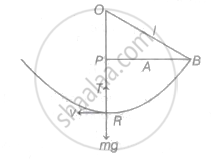Advertisements
Advertisements
प्रश्न
A simple pendulum of length I has a bob of mass m. It executes SHM of small amplitude A. The maximum tension in the string is (g = acceleration due to gravity)
पर्याय
mg
`"mg"("A"^2/"l"^2 + 1)`
2 mg
`"mg"("A"/"l" + 1)`
उत्तर
`"mg"("A"^2/"l"^2 + 1)`
Explanation:
Consider the figure shown below

The string possess maximum tension when bob is at mean position of oscillation i.e., at position R.
From geometry, OP = `sqrt("l"^2 - "A"^2)`
Also, RP = OR - OP = l - `sqrt("l"^2 - "A"^2)`
The whole kinetic energy of bob at position R is converted into its potential energy at position B.
`therefore 1/2 "mv"^2 = "mg"("l" - sqrt("l"^2 - "A"^2))`
`"v"^2 = "2g"("l" - sqrt("l"^2 - "A"^2))`
Balancing forces at R,
T - mg = `"mv"^2/"l" = (2"mg" ("l" - sqrt("l"^2 - "A"^2)))/"l"`
∴ T = mg + 2mg `(1 - sqrt(1 - "A"^2/"l"^2))`
Using approximation, `sqrt(1 - x^2) = 1 - x^2/2` for x << 1, we get
T = mg = 2mg `[1 - (1 - "A"^2/(2"l"^2))]`
= mg + mg`("A"/"l")^2`
= mg `[1 + ("A"/"l")^2]`
